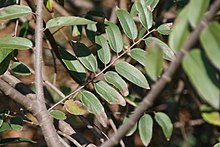| Grewia bicolor | |
|---|---|

| |
| Flowers | |

| |
| Leaves | |
|
Scientific classification
| |
| Kingdom: | Plantae |
| Clade: | Tracheophytes |
| Clade: | Angiosperms |
| Clade: | Eudicots |
| Clade: | Rosids |
| Order: | Malvales |
| Family: | Malvaceae |
| Genus: | Grewia |
| Species: | G. bicolor
|
| Binomial name | |
| Grewia bicolor | |
| Synonyms [1] | |
|
List
| |
Grewia bicolor, called bastard brandy bush, false brandy bush, two-coloured grewia, white-leaved grewia, white-leaved raisin, white raisin and donkey berry (a name it shares with Grewia flavescens), is a species of flowering plant in the family Malvaceae, native to sub-Saharan Africa, Yemen, Oman, and the Indian subcontinent. [1] [2] In Africa Grewia bicolor is one of the most important forages during the dry season, when all herbivores, wild and domestic, find it palatable. It is particularly enjoyed by giant eland ( Taurotragus derbianus) and domestic goats ( Capra aegagrus hircus). [2] Caterpillars of Anaphe reticulata have been found to feed on the foliage. [3]
References
- ^ a b "Grewia bicolor Juss". Plants of the World Online. Board of Trustees of the Royal Botanic Gardens, Kew. Retrieved 26 May 2021.
- ^ a b Heuzé, V.; Tran, G.; Delagarde, R.; Bastianelli, F.; Lebas, F. (15 July 2019). "False brandy bush (Grewia bicolor)". Feedipedia – Animal Feed Resources Information System. Feedipedia, a programme by INRAE, CIRAD, AFZ and FAO. Retrieved 26 May 2021.
- ^ Scholtz, Clarke H.; Holm, Erik (June 1982). "Trophic ecology of Lepidoptera larvae associated with wooded vegetation in a Savanna Ecosystem, Savanna Ecosystem Project (National Programme for Environmental Sciences, Nylsvley Study Area)" (PDF). South African National Scientific Reports (55): 19. Retrieved 27 May 2023.
Categories:
- Grewia
- Forages
- Flora of West Tropical Africa
- Flora of West-Central Tropical Africa
- Flora of Northeast Tropical Africa
- Flora of East Tropical Africa
- Flora of South Tropical Africa
- Flora of Southern Africa
- Flora of Oman
- Flora of Yemen
- Flora of India (region)
- Flora of Nepal
- Flora of Pakistan
- Plants described in 1804
- Malvaceae stubs